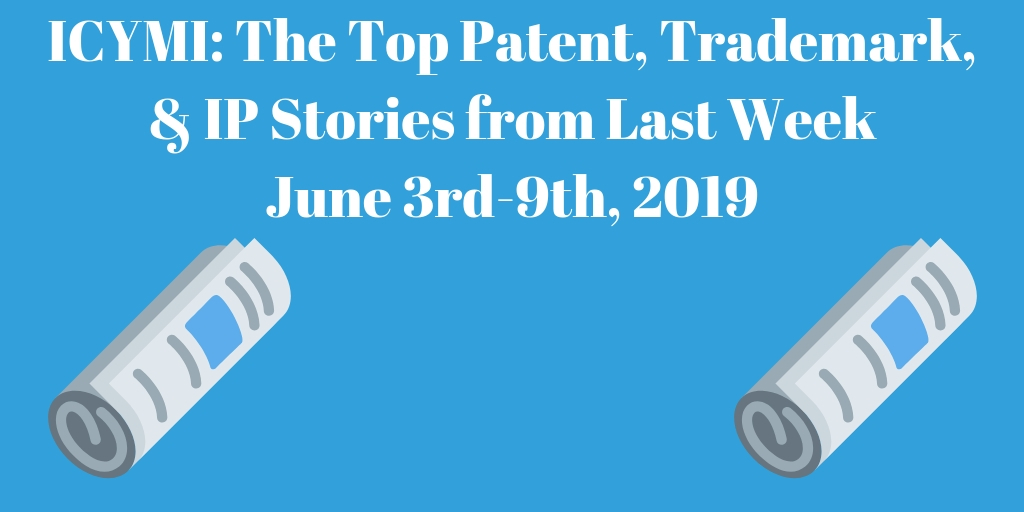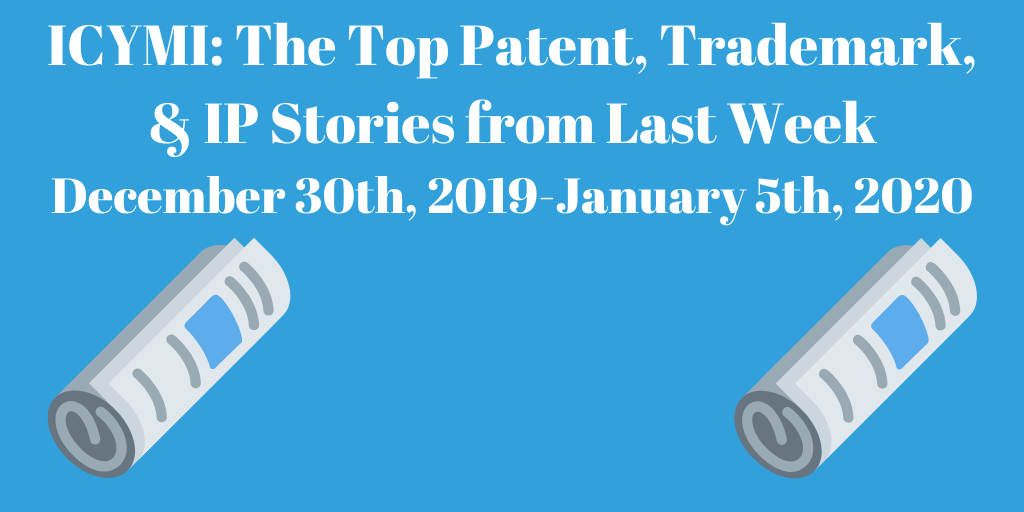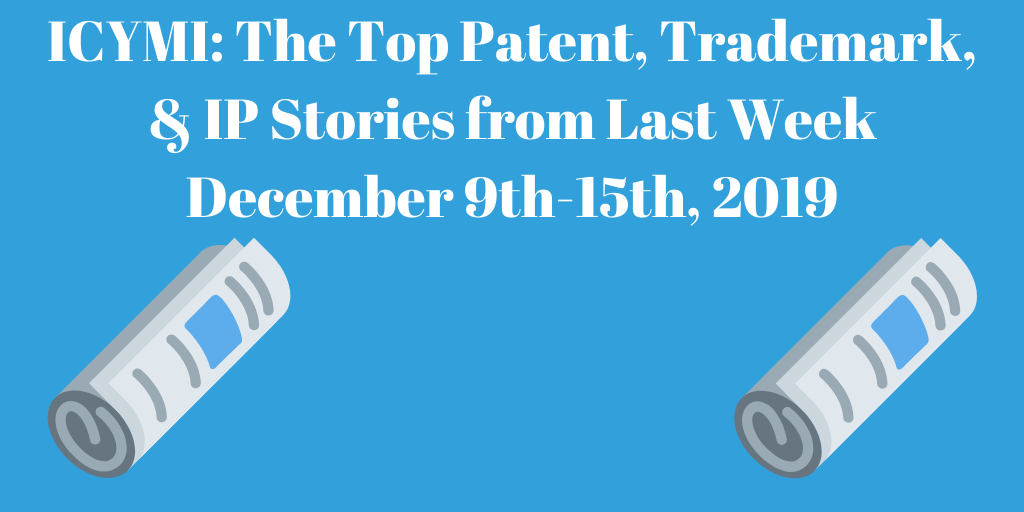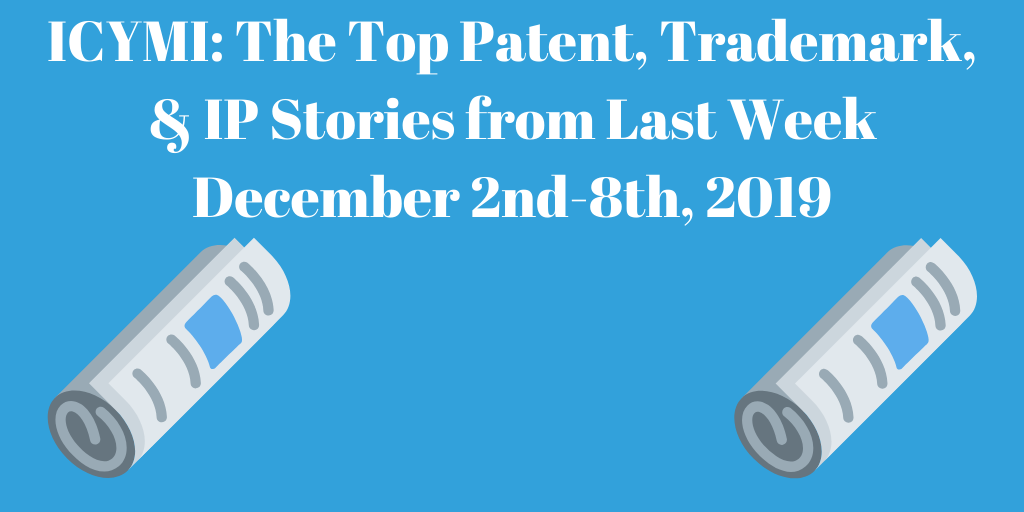Top Patent, Trademark, and IP Stories from Last Week (6/3-6/9/19)
Every week, we will be highlighting the top patent, copyright, trademark, intellectual property, etc. stories of the previous week in our “In Case You Missed It” segment. The list itself is in no particular order and includes a wide range of stories from the patent world that are informative, noteworthy, or just plain bizarre. The stories included encompass everything from Supreme Court cases to insights into growing industries. Please feel free to comment your thoughts on the stories or share an important one we missed!
“Congress Is Debating—Again—Whether Genes Can Be Patented”
In 2013, the Supreme Court heard Association for Molecular Pathology v. Myriad Genetics, Inc. which weighed whether human genes could be patented. The court ruled that naturally occurring DNA segments are considered “products of nature” and therefore not patent eligible. On the contrary, the court ruled that complementary DNA (cDNA), synthesized in labs from RNA, are patent eligible because they do not occur naturally. The ruling has allowed companies like 23andMe to exist because they are able to test customers’ genes and give them an analysis.

The question the case raised is now under the spotlight again as a bipartisan draft bill was recently proposed to modify Section 101 of the Patent Act. The bill will ease restrictions on patent eligibility, many of which were instituted by previous Supreme Court hearings. Changes to the act included in the proposal:
- Defining “useful” in Section 100 as “any invention or discovery that provides specific and practical utility in any field of technology through human intervention”
- Section 101(a): “Whoever invents or discovers any useful process, machine, manufacture, or composition of matter, or any useful improvement thereof, may obtain a patent therefor, subject to the conditions and requirements of this title.”
- Section 101(b): “Eligibility under this section shall be determined only while considering the claimed invention as a whole, without discounting or disregarding any claim limitation.”
- “Functional Claim Elements— An element in a claim expressed as a specified function without the recital of structure, material, or acts in support thereof shall be construed to cover the corresponding structure, material, or acts described in the specification and equivalents thereof”
- “No implicit or other judicially created exceptions to subject matter eligibility, including ‘abstract ideas,’ ‘laws of nature,’ or “natural phenomena,’ shall be used to determine patent eligibility under section 101, and all cases establishing or interpreting those exceptions to eligibility are hereby abrogated.”
- “The eligibility of a claimed invention under section 101 shall be determined without regard to: the manner in which the claimed invention was made; whether individual limitations of a claim are well known, conventional or routine; the state of the art at the time of the invention; or any other considerations relating to sections 102, 103, or 112 of this title.”
Opponents of the bill include renowned scientific and medical organizations who feel the bill would allow for genes to be patented and open research scientists up to constant legal liability. Additionally, patient advocacy groups fear patients will have a harder time accessing diagnostic tests if the bill is passed. The ACLU stated such a proposal would allow patent-holders to determine who can research the genes and who could test for genetic mutations.
In light of the outcry, Sen. Coons stated the bill would “not change the law to allow a company to patent a gene as it exists in the human body.” Despite such remarks however, there is not a lot of confidence in the answer considering how greatly it conflicts with the proposed changes. The proposed modifications to the act still leave a lot of questions over genetic patent eligibility.
Just as with most changes to patent law via congress or the Supreme Court, the rulings and legislation in those instances may create severe headaches for a particular industry. The ambiguity of genetic and science-related patent eligibility needs to be addressed. To read more about this story, click here (via Wired, June 5th, 2019).
For more information on DNA, its components, and functions, click here for an in-depth guide
“Supreme Court Agrees to Review Filmmaker’s Copyright Lawsuit Against North Carolina”
Last week, the Supreme Court agreed to hear Frederick Allen and Nautilus Productions, LLC v. Roy A. Cooper, III, et al. after a petition from Rick Allen, owner of Nautilus Productions. In 2013, Allen sued North Carolina for copyright infringement after they posted the pictures he took of Blackbeard’s shipwreck expedition on their website. After removing the photos, the state government then proceeded to post videos Allen took of the wreck at which point Allen filed suit again. Shortly after, state lawmakers in North Carolina passed a bill dubbed “Blackbeard’s Law” that makes any video or photograph of a shipwreck public record.6
The Supreme Court must now decide whether states can be sued for using copyrighted material without permission or whether it is protected by sovereign immunity. A lower court previously found the state could not be sued. In 1990, a law was passed forbidding the use of protected material by the government however Supreme Court cases granting states immunity overlapped this ruling. This ambiguity should be resolved in the Supreme Court next fall. To read more about this story, click here (via The Hollywood Reporter, June 3rd, 2019)
“Apple Seeks AR Glasses Patent for Hiding Secret Documents at Work”
A new patent filed by Apple would enable users wearing a virtual reality headset see virtual documents and files on a computer screen. As a person is using the headset at a computer, any outside observer would see a fake screen with phony documents displayed. Such a device would allow users to view confidential documents on a screen without the risk of outsiders compromising that information. These documents would be stored in a drive only accessible via the headset. This could have applications in a whole array of industries where discreet material is disseminated.

Another security feature Apple outlined in the patent is a virtual keyboard that would fit over the physical keyboard of the computer. This would enable users to change up the keys on the virtual keyboard while continuing to type on the physical keyboard. Only the virtual key strokes would be inputed. This would prevent onlookers from knowing what is truly being typed.
With cameras everywhere and the ability to steal classified trade secrets with a smartphone camera, such a device could truly revolutionize IP protection at companies. To read more about this story, click here (via VentureBeat, June 6th, 2019).
“Kawhi Leonard Is Suing Nike for His ‘Klaw’ Logo”
NBA superstar Kawhi Leonard has filed a copyright infringement suit against Nike. Leonard alleges the brand stole an original logo he designed in college without his consent. The suit also outlines Leonard’s personal attachment to the logo, stating the logo includes elements “meaningful and unique to him.” The logo is an incorporation of Leonard’s infamously large hand, initials, and jersey number.
In 2011, Leonard entered into an endorsement deal with Nike, granting them the right to use his copyright on merchandise while he sold his own merchandise with the logo on the side. During the tenure of the deal, Nike filed for a copyright registration on Leonard’s logo, claiming they designed it. After the endorsement deal ended in November when Leonard signed with New Balance, Nike sent him a cease and desist letter for selling clothing with the logo on it.
The lawsuit is seeking that Nike transfers the logo to Leonard as well as pursue fraud charges for the company falsely indicating they were the creators of the logo to the USPTO. As Leonard enters free agency this summer, it is imperative that he is able to market himself using the logo. To read more about this story, click here (via GQ, June 4th, 2019).




